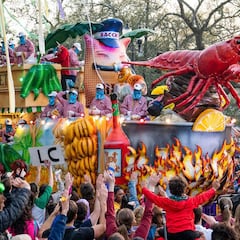Mardi Gras 2023: Why is it called Fat Tuesday?
Mardi Gras, otherwise known as “Fat Tuesday”, encompasses the festive celebrations that take place along the Gulf Coast, but what’s behind the name?

Mardi Gras is the name used in the United States for the weeks-long festivities known as Carnival in other parts of the world. The final day of the celebrations takes place on Fat Tuesday, the literal translation from French of Mardi Gras. Lest you are a seasoned observer and participant of the merrymaking, you may be asking yourself what’s behind the name.
The answer lies in what comes after. The following day is Ash Wednesday which is the start of the forty-day Christian period of fasting and religious observance known as Lent in the lead-up to Easter. In order to avoid temptations during those roughly six weeks people empty out their cupboards and pantries of all the delectables, especially the fatty foods.
Why is Mardi Gras called Fat Tuesday?
While the Mardi Gras celebration begins on 6 January with the Epiphany, the last feast day of Christmas, the festivities ramp up in the last couple weeks before Fat Tuesday, whenever it may fall each year. Come midnight when Fat Tuesday, also called “Shrove Tuesday” turns into Ash Wednesday, all that indulgence ends.
Make a batch perfect for your Mardi Gras fete (and leftovers the next day).https://t.co/ggfqP5M3n0
— Chicago magazine (@ChicagoMag) February 10, 2023
The same principle goes for Carnival, which according to the Merriam-Webster dictionary, the word is derived from “Italian carnevale, alteration of earlier carnelevare, literally, removal of meat, from carne flesh (from Latin carn-, caro) + levare to remove, from Latin, to raise.”
Related stories
During Lent Christians abstain from eating meat, as part of their solemn remembrance of Jesus Christ’s 40 days spent in the desert fasting and enduring temptation by Satan. Its typical to give up other luxuries as well.
“Shrove,” for its part comes from the verb “shrive” which means “to administer the sacrament of reconciliation” and “to free from guilt.”


